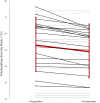Impact of spinal fusion on severity health status in scoliotic adolescents with polyhandicap
- PMID: 38451892
- PMCID: PMC10919586
- DOI: 10.1371/journal.pone.0300065
Impact of spinal fusion on severity health status in scoliotic adolescents with polyhandicap
Abstract
Background: Scoliosis constitutes a prevalent comorbidity in adolescents with polyhandicap and frequently leads to other severe impairments, impacting abilities and requiring complex caregiving strategies. Therefore, spinal fusion surgeries are commonly performed to alleviate pain and provide more comfort. However, spine stabilization has not previously been proven to improve the severity health status of adolescents with polyhandicap according to specific clinical scales.
Objective: This study describes and compares the severity health status of adolescents with polyhandicap before and after they underwent spinal fusion.
Methods: A monocentric retrospective observational study was conducted in the university hospital centre of Saint-Etienne, France. We included between 2009 to 2020, 30 scoliotic adolescents with polyhandicap who underwent spinal fusion performed with the same surgical technique and the same surgeon. The main outcome was the variation in the Polyhandicap Severity Scale (PSS) score after surgery. Secondary outcomes were variations in PSS subscores, quality of life scores, fronto-sagittal X-ray parameters, and measures of surgical complication rates and lengths of stay.
Results: Among 30 adolescents, 27 PSS analyses were performed. We found a significant improvement between pre- and postoperative PSS scores, mainly for pain and respiratory, digestive, and skin disabilities. These improvements were accompanied by significant reductions in pelvic obliquity, in frontal and sagittal curves. The mean hospital length of stay was 45 days. During postoperative period, patients received a personalized postoperative rehabilitation procedure with spasticity and pain treatments, physiotherapy, and verticalization (wheelchair sitting and positioning devices such as contoured seat intended to increase postural stability). The mortality rate was estimated at 7%. At least 1 complication per patient occurred.
Conclusions: We show that spinal fusion surgeries confer a significant improvement in the severity health status in scoliotic adolescents with polyhandicap.
Copyright: © 2024 Bessaguet et al. This is an open access article distributed under the terms of the Creative Commons Attribution License, which permits unrestricted use, distribution, and reproduction in any medium, provided the original author and source are credited.
Conflict of interest statement
The authors have declared that no competing interests exist.
Figures





Similar articles
-
Surgical correction of spinal deformity in patients with congenital muscular dystrophy.J Orthop Sci. 2010 Jul;15(4):493-501. doi: 10.1007/s00776-010-1486-9. Epub 2010 Aug 19. J Orthop Sci. 2010. PMID: 20721717
-
A 10-Year Radiographic Study Comparing Anterior Versus Posterior Instrumented Spinal Fusion in Patients With Lenke Type 5 Adolescent Idiopathic Scoliosis.Spine (Phila Pa 1976). 2020 May 1;45(9):612-620. doi: 10.1097/BRS.0000000000003331. Spine (Phila Pa 1976). 2020. PMID: 31770332
-
Long-term outcomes of transforaminal lumbar interbody fusion in patients with spinal stenosis and degenerative scoliosis.Spine J. 2018 Jun;18(6):1014-1021. doi: 10.1016/j.spinee.2017.10.063. Epub 2017 Nov 22. Spine J. 2018. PMID: 29174460
-
What is the Role of Scoliosis Surgery in Adolescents and Adults with Myelomeningocele? A Systematic Review.Clin Orthop Relat Res. 2022 Apr 1;480(4):773-787. doi: 10.1097/CORR.0000000000002087. Clin Orthop Relat Res. 2022. PMID: 34939968 Free PMC article.
-
Survival of patients with Duchenne muscular dystrophy who underwent spinal deformity correction.Dev Med Child Neurol. 2024 Feb;66(2):187-194. doi: 10.1111/dmcn.15711. Epub 2023 Jul 21. Dev Med Child Neurol. 2024. PMID: 37482906 Review.
Cited by
-
Impact of caring for patients with polyhandicap on institutional health care workers' quality of life: a cross-sectional and longitudinal evaluation.Front Public Health. 2024 Oct 18;12:1427289. doi: 10.3389/fpubh.2024.1427289. eCollection 2024. Front Public Health. 2024. PMID: 39494083 Free PMC article.
References
-
- Chabrier S, Pouyfaucon M, Chatelin A, Bleyenheuft Y, Fluss J, Gautheron V, et al.. From congenial paralysis to post-early brain injury developmental condition: Where does cerebral palsy actually stand? Ann Phys Rehabil Med. 2019. Aug;S1877065719301137. doi: 10.1016/j.rehab.2019.07.003 - DOI - PubMed
-
- Maes B, Nijs S, Vandesande S, Van Keer I, Arthur-Kelly M, Dind J, et al.. Looking back, looking forward: Methodological challenges and future directions in research on persons with profound intellectual and multiple disabilities. J Appl Res Intellect Disabil. 2021. Jan;34(1):250–62. doi: 10.1111/jar.12803 - DOI - PubMed
-
- Mensch SM, Echteld MA, Lemmens R, Oppewal A, Evenhuis HM, Rameckers EAA. The relationship between motor abilities and quality of life in children with severe multiple disabilities: Motor abilities and quality of life in children with SMD. J Intellect Disabil Res. 2019. Feb;63(2):100–12. - PubMed
-
- Gautheron V, Mathevon L, Bayle B, Boulard C, Paricio C, Seeman E, et al.. Problèmes respiratoires des personnes polyhandicapées: le point de vue du médecin de médecine physique et de réadaptation. Mot Cérébrale Réadapt Neurol Dév. 2015. Jun;36(2):49–53.
Publication types
MeSH terms
LinkOut - more resources
Full Text Sources
Medical

